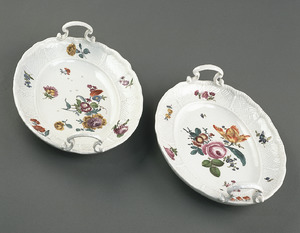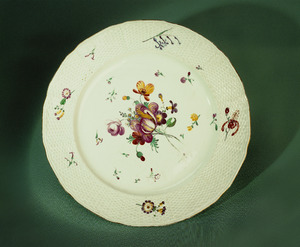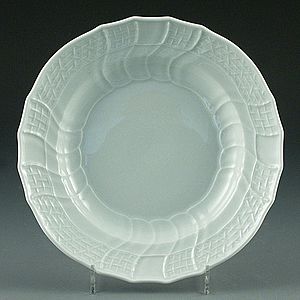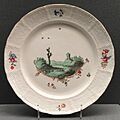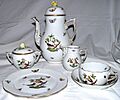Osier pattern facts for kids
The Osier pattern is a special design found on porcelain plates and other flat dishes. It looks like a woven basket, with delicate raised patterns around the edges. This unique style started in Germany in the 1730s at the famous Meissen porcelain factory. Other factories later copied this beautiful design.
It's thought that Johann Joachim Kaendler, a very talented artist at Meissen, created the Osier pattern. The name "Osier" comes from a type of willow tree called Salix viminalis. This willow has thin, flexible branches that people use to make wickerwork, like baskets. The pattern on the porcelain looks just like these woven willow branches!
Contents
Meissen's Special Designs
Meissen was known for its amazing raised patterns. Besides the Osier pattern, they made others like the "Dulong border" from 1743, which had a plant-like design.
One of their most famous designs was the "Swan Service." Each plate in this service had a delicate background with wavy lines, like a scallop shell. In the middle, there were two swans on water, surrounded by bullrushes. A crane was flying down to join another crane on the left. The standing crane held a fish in its beak, and another fish's head could be seen in the water.
Different Osier Patterns
Meissen actually made three main versions of the Osier pattern, with small differences in how they were molded.
The First Osier Design
The first type of Osier pattern was made from about 1732. It was used for a large dinner set for Count Alexander Joseph Sulkowski around 1735. This pattern is called the "ordinary osier" or "Sulkowski type." It had small groups of woven shoots that went diagonally to the edge of the plate. These groups formed squares with other groups placed at right angles. Straight vertical bands separated these woven sections. The inner and outer edges of the pattern sometimes had striped bands, also looking like woven basketwork.
The Old and New Osier Styles
Soon after the first type, a second version was created. This one had finer woven shoots that all went in the same direction, parallel to the plate's edge. It didn't always have the straight vertical strips. After a third version came out in 1742, this second type became known as the "Altozier" or "old ozier."
The third version, called the "Neuozier" or "new osier," was more fancy and swirly, like the rococo art style. In this design, the vertical strips or ribs curved into an "S" shape. They were also more noticeable and often extended into the flat center part of the plate, going beyond the woven basket pattern. The woven part might only cover about half of the raised border. A raised line marked the inner edge of this pattern.
Both the "old" and "new" Osier patterns are still made today. The center of the plate is usually plain, except for some "new osier" designs. Larger pieces that aren't flat, like cups or tureens, often don't have the raised pattern.
Images for kids


